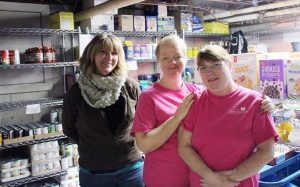Community Garden donates to women’s shelter

Pictured from left to right: Volunteer coordinator, Anastasia Adams and volunteers Zachara Beemer and Kathy Gervais inside the Welcome Centre food bank. (photo by Kacie Cooper)
By Kacie Cooper
For many people in Windsor, a community garden is more than just growing fruits and vegetables. It is also about sustainability and permaculture.
Rita Haase and Tanya Basok are two leading members of the Campus Community Garden at the University of Windsor. They said they are dedicated to caring for and maintaining the garden. They said they bring the community together.
They also place an emphasis on education, teaching self-sufficiency, environment and biology, with both Haase and Basok teaching courses at the university.
“One of the main ideas is to bring the community together, and the other idea is to help people become self-sustainable,” said Haase.
Haase has been involved with the program since 2010 and has coordinated the program for three years. Basok said she has been coordinator of this community garden location for the past two years.
Preparation for the garden starts in April and planting begins in May. Every year grants are applied for and donations of mulch, compost and seeds are accepted to help with costs.
“In other places I have visited, usually there is just beds used as individual plots, whereas here we maintain it as a garden based on the principle of permaculture,” said Basok. “Permaculture is about sustainability and about having nature contribute to what you need.”
Examples of this would include growing plants that draw pollinating insects such as bees and monarch butterflies toward the garden; growing fennel which acts as a natural pesticide by attracting predatory insects; and the use of rain water.
In the spring, tours are held for high school students to learn about the gardens. The organization teaches elementary school children, high schoolers and university students about the gardens. They are hoping to reach out to St. Clair College’s horticultural programs to bring education on the community gardens to college students in the area.
The garden has only three rules for being part of their organization: everything must be organic, one is asked to contribute on work days and 10 per cent of all produce is used for donation.
On average, this community garden donates around 150 pounds of produce to women’s shelters in the area every year, sometimes even several hundred pounds.
The Welcome Centre, a women’s shelter and food bank located on Bridge Avenue, is one of these shelters.
Anastasia Adams, the volunteer and kitchen coordinator for the Welcome Centre for the past two and a half years, works directly with organizations such as the Campus Community Garden. Fresh produce is provided to not only the women who stay in the shelter, but also the families who regularly come to the food bank when resources permit.
“A lot of the other food banks in the association [Food Bank Association], that’s all they do, whereas our food bank is just one little part. We are primarily a homeless shelter and that’s the focus of our organization,” said Adams. “That’s why it’s really important when we do receive support from the local community gardens because we might not necessarily have access to that stuff [produce]”
The Welcome Centre food bank is run by 10 volunteers. On a monthly basis, 100 or more families visit the food bank, which can range anywhere from 250 to 275 people.
When training new volunteers to work at the food bank, Adams said they stress the importance of speaking to people how they would want to be spoken to themselves.
“There is no one solid reason that people end up in need of a food bank or being homeless. There’s a lot of different reasons, and we need to leave our judgement at the door.”


